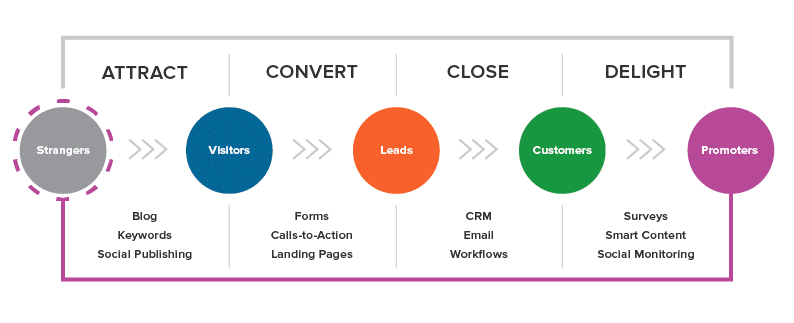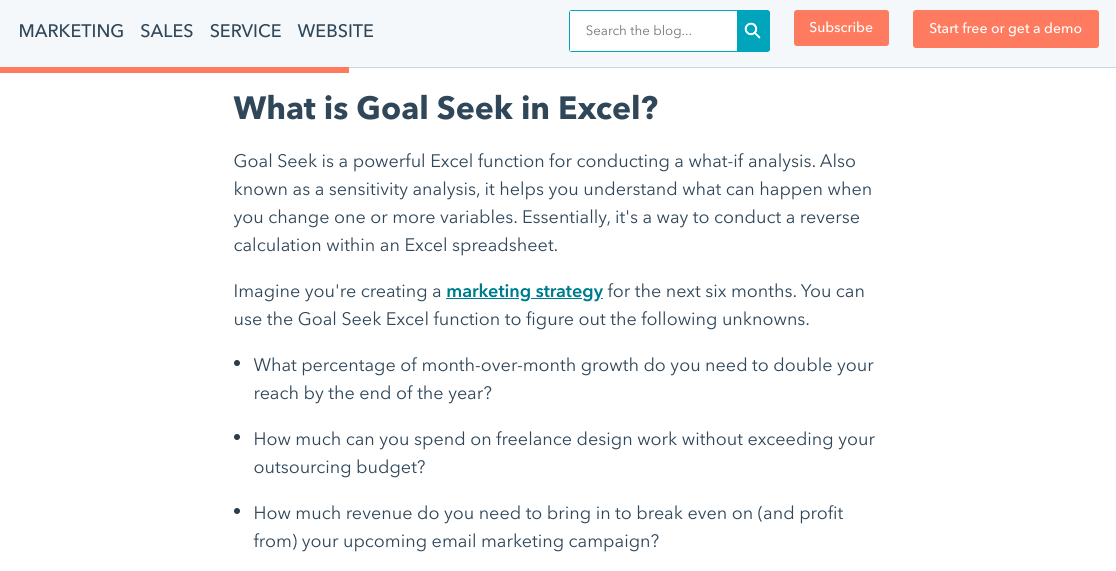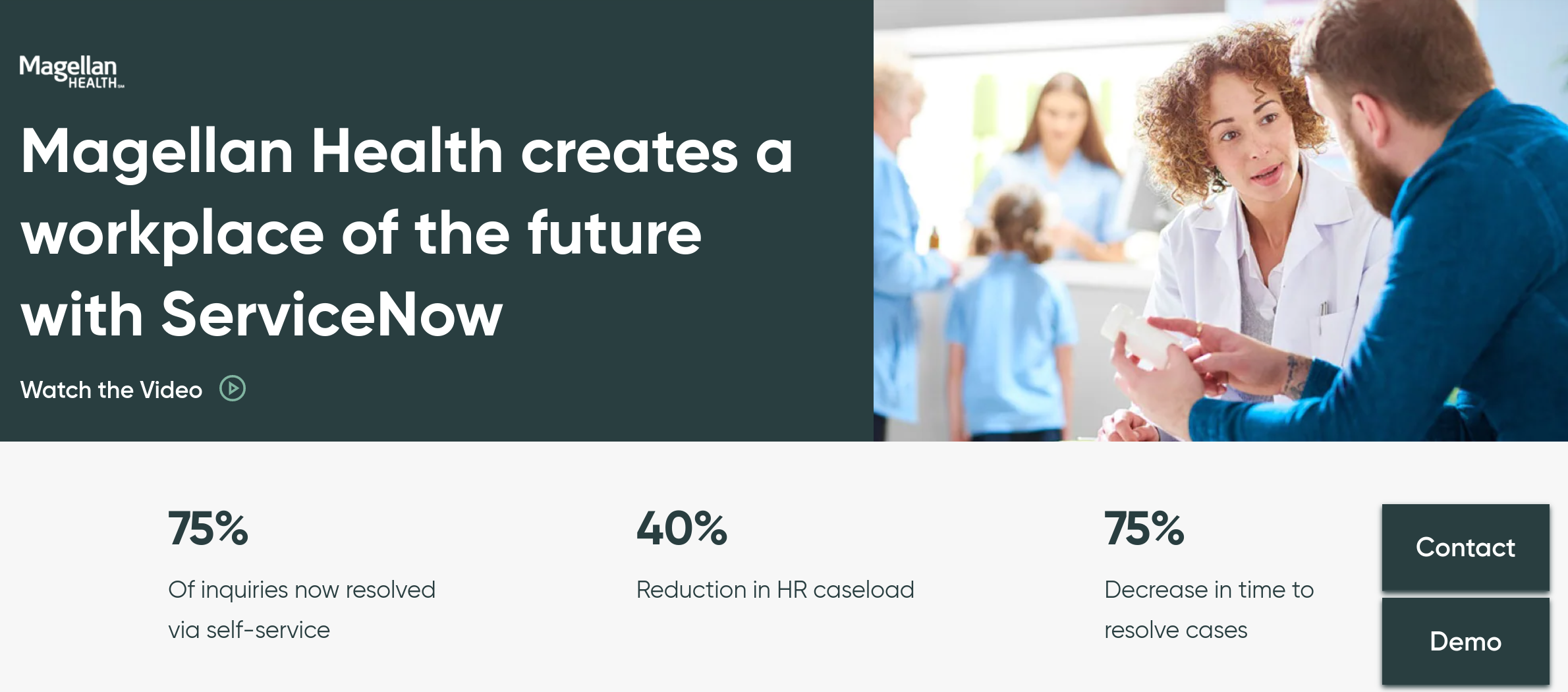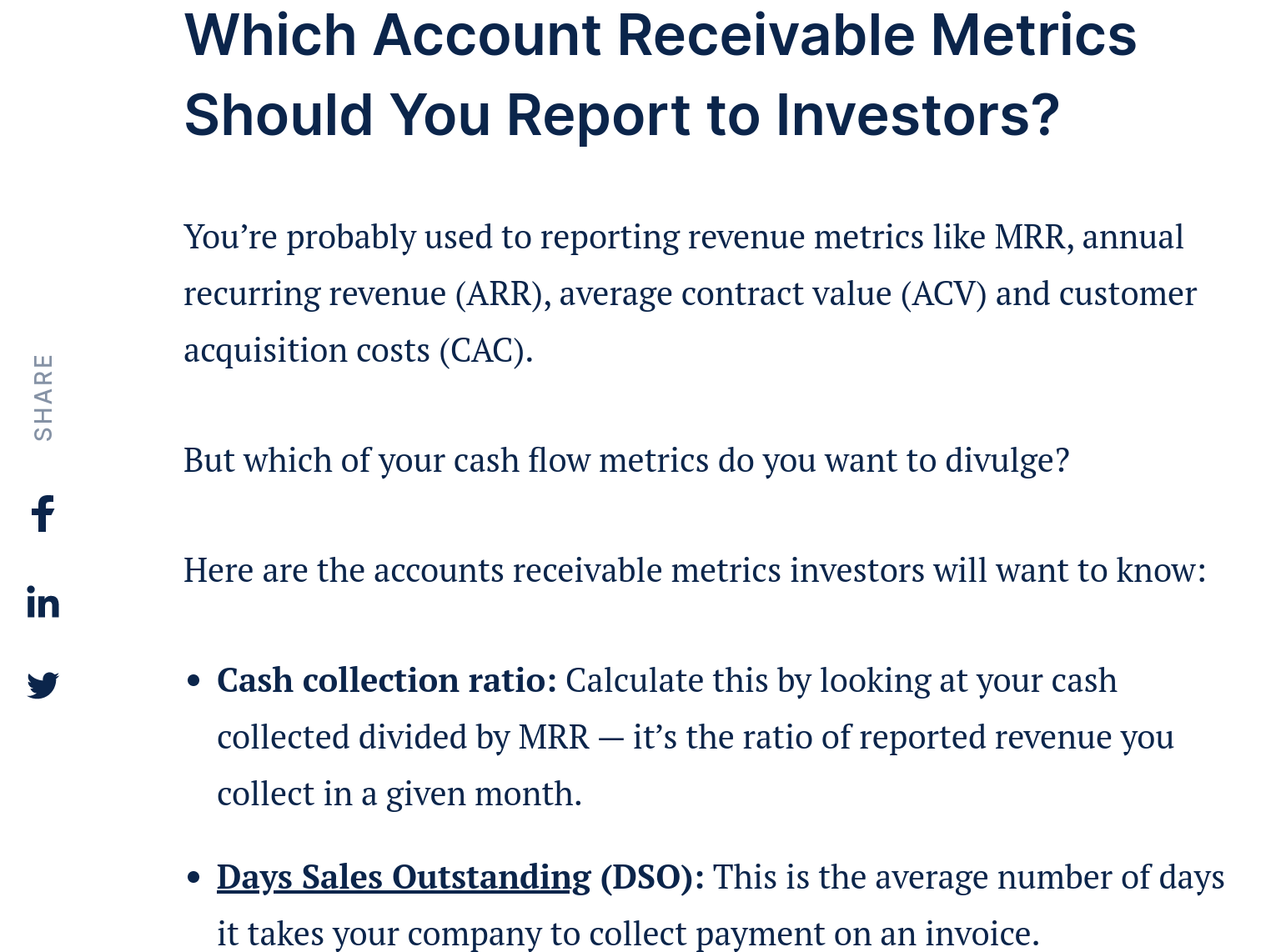What if instead of you having to expend considerable time, money and effort to reach them, a B2B customer came to you? This is the core value proposition of inbound marketing.
Instead of the cold calls and paid ads of a classic outbound marketing strategy, B2B inbound marketing uses customized content—ranging from social media posts to company blog posts, such as this one!—to attract members of a target audience and ultimately convert them into sales.
Basically, an inbound marketing B2B strategy is more magnet than megaphone, more pull than push.
It aims to create something irresistible that naturally attracts a customer’s attention while they’re already on their journey, without overwhelming them with the unsubtle collateral and points of contact of outbound. The end result of an inbound strategy is the conversion of tangential connections to a brand—e.g., visitors to its website—into customers who happily promote it. Inbound marketing follows a 4-stage process:

For B2B purposes in particular, inbound marketing is a reliable, cost-effective way to attract a customer’s attention and build trust with them over the course of a relatively long B2B sales cycle. Let’s examine the fundamentals of B2B inbound marketing so that you can build or refine your strategy.
“An inbound marketing B2B strategy is more magnet than megaphone, more pull than push.”
Subscribe to
The Content Marketer
Get weekly insights, advice and opinions about all things digital marketing.
Thank you for subscribing to The Content Marketer!
B2B Inbound Marketing: What It Is and How It Works
B2B inbound marketing is the methodology of attracting business customers in, through a soft-touch compelling content strategy, instead of pushing marketing messages out to them via more overt outbound channels. It’s inviting instead of interrupting.
Successful B2B inbound strategies culminate in a company’s website and social media accounts. These platforms become hubs for their corporate audiences and thus powerful platforms for lead generation.
If you build it, they will come, you might say.
Search engine optimization (SEO) and social media strategy are among the practices that create the “pull” effect of inbound marketing.
What does B2B inbound marketing look like in action? Let’s turn to the company that’s nearly synonymous with the term—HubSpot. Its official blog is a watering hole for inbound marketers everywhere, not just because it’s supercharged for SEO, but it’s also reliably informative and has its finger on the pulse of the latest trends in inbound, marketing automation and more. Here’s a characteristic post about how to use the Goal Seek functionality in Microsoft Excel:

Authoritative, readable and relevant—this post has all the hallmarks of standout inbound marketing content.
It conveys real value to the reader with its lede about how Goal Seek will fit into the audience’s upcoming campaigns and projections. HubSpot isn’t making a direct sales pitch here, but it is establishing itself as a trustworthy source and business partner, a move which will in turn make its audiences likelier to do business with it.
Overall, inbound marketing relies heavily on custom content that addresses a wider range of audience needs than narrower outbound marketing formats such as direct mail. Inbound also heavily leverages marketing automation tools, inbound marketing software and SEO best practices.
To really see how B2B inbound marketing works, we need to compare its most common formats side by side with those of outbound:
| Types of Inbound Marketing | Types of Outbound Marketing |
|
|
Why You Need a B2B Inbound Marketing Strategy
OK, so we have a general sense of what B2B inbound marketing is. Now, let’s answer the next most common question about it: Why should you pursue inbound in the first place?
A simple answer might be that people prefer not to be interrupted by outbound marketing, and for that reason alone inbound marketing is superior. I mean, when’s the last time you had a pleasant experience with a cold call or clicked through a pop-up ad to buy something?
However, the advantages of inbound marketing for B2B organizations run deeper than it simply seeming more pleasant for the customer. Let’s examine some of the big reasons why an inbound marketing strategy is a smarter approach than relying exclusively on outbound.
Reason No. 1: B2B Inbound Marketing Generates Higher-Quality Leads
When a B2B buyer finds you via an inbound digital marketing channel, they’re much likelier to close than if they had connected through an outbound strategy. According to Search Engine Journal, inbound leads have a close rate of 14.6%, compared to just 1.7% for outbound leads.
Moreover, the typical B2B marketer now prioritizes lead quality over lead quantity. Outbound B2B marketing is quantity-driven—it’s often just about working your way through a list of phone numbers or email addresses, trying to catch lightning in a bottle. But inbound is focused on quality, through attracting and nurturing a very engaged audience.
Ascend2 found that 70% of B2B marketers cited “improve quality of leads” as their top priority. Inbound marketing is the most efficient way to do so.
Reason No. 2: B2B Inbound Marketing Is More Cost-Effective
B2B digital marketing budgets are frequently under pressure. Businesses must reallocate funds throughout the years, or make sudden cuts due to events such as the COVID-19 pandemic. Gartner found that almost half (44%) of CMOs saw such cuts in 2020.
In this context, cost-effectiveness is key. The typical inbound marketing lead is 68% less expensive than an outbound equivalent for companies with 51 to 200 employees, per Marking2Connect.
This makes sense. With outbound marketing, you are paying to slice off a portion of someone’s attention, for instance by buying a search ad. With B2B inbound marketing, you are building assets that should organically engage customers, because you are putting the customer first and meeting them where they are. As an added bonus, this approach is much more economical than paying for their attention.
Reason No. 3: B2B Inbound Marketing Is Customer-Centric
That brings us to our third reason to implement B2B inbound marketing—it puts the customer and their needs first. For B2B inbound purposes, that means educating customers and providing a consistent stream of resources that they can consult during typically long sales cycles.
Compared to B2C buyers, B2B customers are more interested in being educated by their potential business partners, since they want to understand all of the opportunities and liabilities of a product or service before buying it. Inbound marketing is simply much better suited to this purpose than outbound is.
Speaking to a prospect through an SEO blog post, landing page or email newsletter gives your messages more credibility and flexibility. You’re not limited by the constraints of the outbound marketing world (e.g., time limits on ads) and can instead focus on what specific customers need.
4 Examples of B2B Inbound Marketing in the Real World
There are many types of B2B inbound marketing, so how do you choose the ones right for your business? Let’s explore some examples to see what’s possible.
Atlassian’s Teamistry Podcast
With inbound, marketers can do almost anything they think will attract and convert prospects. For example, instead of paying to run a display ad that’s similar to everyone else’s, a B2B firm might do longer-form, customized content marketing like podcasting.
B2B software vendor Atlassian shows off these types of possibilities across its marketing channels. Its Teamistry podcast is a seasonal series about legendary team efforts, with episodes covering events like how IBM adjusted to the initial growth of the internet.
Season 3 of #Teamistry is here! In episode one, you’ll hear about the team of innovative thinkers who convinced IBM’s top brass that a revolution was at their doorstep. Listen now: https://t.co/z6Mr0hyIXg pic.twitter.com/IoCyXep0Dl
— Atlassian (@Atlassian) June 7, 2021
Why it works better than outbound: Whereas a display ad for Atlassian might catch a customer’s attention momentarily, this podcast series engages them for 30 minutes at a time, and in a much more in-depth way. They learn about how Atlassian sees the world and what it values—something there isn’t as much room for in outbound materials.
ServiceNow’s Case Studies
Workflow automation provider ServiceNow has published numerous case studies on its main site, showing off how its software has tangibly benefited its B2B customers. The case study format is perfect for inbound marketing by showing rather than telling. Readers get to see the brand demonstrating how it adds value.
The headline and statistics work well together to give a high-level overview of the case study before the text even begins. There’s also strategically located “contact” and “demo” buttons to move a reader’s interest further down the sales funnel.

Why it works better than outbound: Cold-calling a business to sell them on workflow automation software is a numbers game. It would take a lot of calls to see any success, considering the complexity of the products and services in question. In contrast, inbound case studies make the value proposition clearer and easier for the customer to experience on their own terms.
Upflow’s SEO Blog Posts
B2B payments startup Upflow has a well-designed blog that caters to its audience of businesses who are looking to more efficiently collect customer payments. The post captured below is easy to read and tailored for SEO. There’s a subhead question with a clear answer, bullet points for readability and explanations of common industry acronyms throughout.

Why it works better than outbound: Upflow is demonstrating its keen understanding of how its audience works while also giving them expert advice on what to track. This type of content marketing is more nuanced than a “try Upflow, we’re the best at collecting B2B payments” pitch.
How Can You Optimize Inbound Marketing Performance?
Getting the most mileage from an inbound marketing campaign requires three main steps:
- Optimizing your website.
- Tracking and acting on key performance indicators (KPIs).
- Promoting your inbound content.
Let’s take these one at a time.
Optimizing Your Website
SEO is a cornerstone of inbound marketing. So to make inbound really work, you’ll want to:
- Focus on on-page and off-page SEO, e.g. by building out your internal linking strategy.
- Optimize each blog post or other asset for a longtail keyword and buyer persona.
- Include relevant CTAs at the end of the asset or somewhere else within it.
Buyer personas, which are research-based fictional representations of ideal customers, really help to shape the length, tone and content of your inbound marketing assets. Remember, inbound marketing is the opposite of the one-size-fits-all approach that outbound marketing usually takes. Accordingly, it pays to build out these specific buyer personas to ensure granular messaging and targeting.
Tracking and Acting on KPIs
Inbound marketing has no shortage of KPIs you can track to see if your efforts are connecting and where they can be improved. To stay on top of them and take corrective action as needed, you’ll want to rely on marketing automation tools that help track leads, interface with CRMs and scale email marketing, among other purposes.
One of these marketing automation tools, Marketo, recommends the following KPIs as guide posts for inbound marketing:
- Social media engagement.
- Month-over-month growth in organic site traffic.
- Lead generation by channel and content type.
- Percentage of leads from inbound sources.
- Forecasted conversion via inbound.
Promoting Your Inbound Content
Just because B2B inbound marketing foregoes the heavy-handed approach of outbound digital marketing doesn’t mean that no content promotion is required.
Social media and email are typically the two biggest amplifiers for inbound marketing assets.
You’ll want marketing automation tools that can cross-post to multiple social media channels and simplify actions such as adding images to posts. For email, so much depends on the subject line, the introduction, the CTA, and—pivotally—whether the message will go into “Promotions” limbo in Gmail or be caught by the somewhat aggressive spam filter in the Apple Mail client.
Investing the initial time and energy to get inbound marketing right is worth it, as it provides a much more sustainable lead generation engine than outbound marketing ever can.





